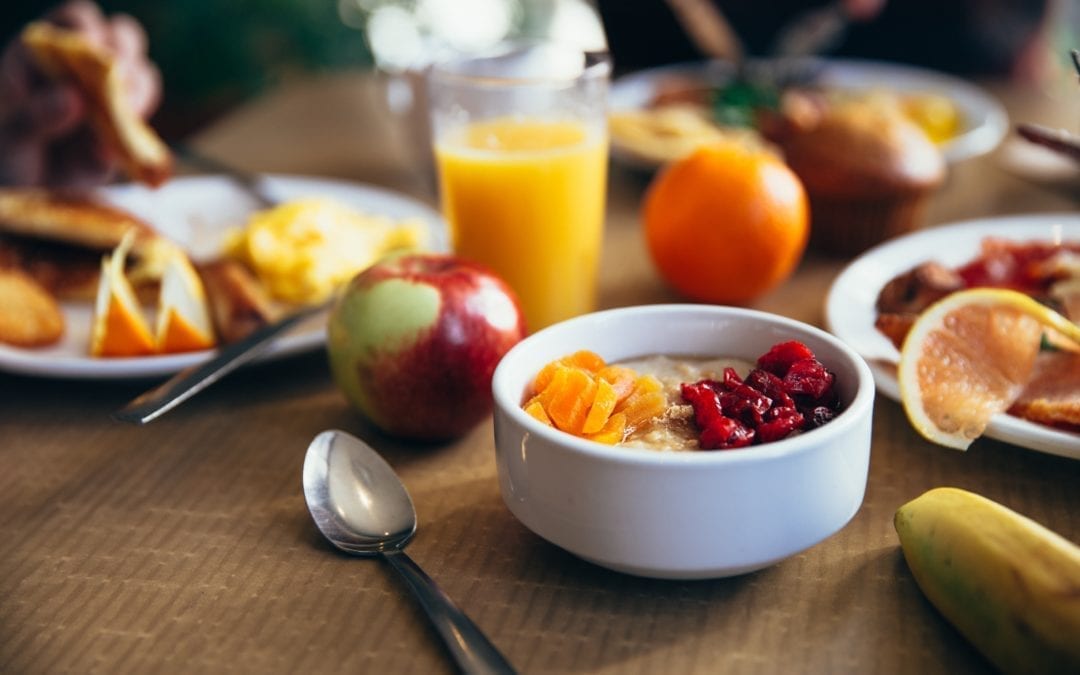If you joined my family for dinner, you would most likely comment on not only how much my kids eat but what they eat as well. Seriously, the term “garbage disposal” has been used for more than one child on separate occasions. I’d like to think they have healthy appetites like myself and that they’re in tune with their healthful side, but a big part of it really may just be having a Dietitian for a mom. These tips aren’t really tricks for me, they’re intuitive and I hope by sharing them with you, you may also develop healthy eaters as well. Just be careful, you may watch that grocery budget soar.
- Cut the snacks. If I could offer you one piece of advice (cue the sunscreen song, or maybe you’re not from that era), this would be it. Children’s stomachs are small and those handfuls of goldfish and graham crackers go a long way in filling them up. My three-year-old lives for snacks but if I can keep her away from the pantry in the afternoons, she literally clears her entire plate at dinner. Parents think kids don’t like certain foods because they don’t eat at mealtimes, but if you ate string cheese, peanut butter crackers, and a banana a few hours before a meal, you probably wouldn’t be very hungry, either. Offer less snacks and you’ll be shocked at the difference in eating behaviors. And always be consistent. If you think your little one doesn’t eat a certain food, don’t you dare give up on it. Put a small amount on their plate and encourage them to try it. Every single time. One day they may just give in. (Especially if they’re famished from lack of snacks).
- Be mindful of sugar. Juice, fruit snacks, fruit pouches, peanut butter, frozen waffles, mini muffins, yogurt—I’m going to stop here but those foods and more can be loaded with added sugars and we both know those are some favs for kids. Children should have no more than six teaspoons of added sugars, or 25 grams per day, and it’s very likely your child is exceeding this amount. What can you do about it? Be mindful for starters—pay attention to the ingredients and what has sugar and what doesn’t. From there, cut out the stuff that isn’t doing them any good—things like juice and fruit snacks. Choose fruit pouches with less sugars added or even better, no sugars added. Make your own waffles, buy peanut butter that’s just peanuts, and aim for plain Greek yogurt with berries. It may not happen overnight, but it is very possible to control and lower the amount of added your sugar your little one gets-you just need to be aware.

- Drink only water. Okay, if your child loves milk, I’m not going to sway you otherwise, but they don’t need to be using milk or any other beverage as a meal replacement. Offer milk only after meals so that they don’t fill up their bellies before eating the good stuff. Aside from that, they should only be drinking water. Juice and God-forbid soda are not doing them any good, unless you consider obesity and tooth decay promising attributes.
- Include them. “What are some ways to hide veggies in my kid’s food?”— this question not only plays like a broken record, but as a Registered Dietitian, it also haunts me. Sneaking vegetables into your littles diet might make you feel good but ultimately, you’re limiting your child in so many ways. During dinner at our house, we talk about how important vegetables are and what they do for us. (We talk about how Daddy needs to improve his intake as well.) Just like all things, my children are easily fascinated by nutrition concepts and they soak it up like sponges. Offer this to your children and you’ll be surprised at how their perceptions change. We also talk about sugar and how much is too much and how it can make you feel sick or tired or grumpy. My poor 6-year-old is so brainwashed aware that on Halloween he said he didn’t want any of his candy after trick or treating because he had so much sugar at school.
In addition to educating them, include them in the meal prep process. Making something like monster muffins, aka banana muffins with a whole lot of spinach, will open their eyes to that green scary stuff and if they like the muffins they may just have good associations with spinach and more leafy greens after the fact.

- Value sleep. You may wonder how we’ve gotten on to the topic of sleep when we’re discussing nutrition—sleep is essential for overall health. Not getting enough can damper the immune system, it can lead to obesity, and worst of all—a child on the verge of a temper tantrum. On average, toddlers and children need between 11 and 14 hours of sleep per day. If your child isn’t getting this and you find they have poor eating and/or behavior habits, considering some more shut eye may be the solution. With proper bedtimes and waketimes, you can establish healthy eating time routines that will encourage your child to eat even better.

- Get them moving. Chances are your SLAM kid can do a burpee better than you can so continue to encourage that behavior. Push for family walks or runs, chase them around the yard, talk about how exercise gives you a healthy heart. Instilling these habits early on promotes wellness that can last a lifetime. And typically, athletes tend to eat well, so you’re paving the road for good nutrition as well.
7. Breakfast is everything. Breakfast sets a precedent for the day. If your little one starts with a good meal first thing in the morning, they’ll be less hungry for snacks the rest of the day. They’ll have energy for school, they’ll be happier, and they’ll be well-fueled. Come up with a routine that works for you and find foods that they love that will provide energy and fiber to keep them full and zooming around.
8. Sit for Meals. Sitting down to eat, especially as a family, is good on so many levels. It provides bonding time which can be so hard to get during these busy days, it promotes good associations with eating, and it treats mealtimes as mealtimes, which is what leads to feeling full and content, thus not needing to eat again 10 minutes later (I promise, my kids do this, too, but sitting for meals will definitely help).
9. Enjoy Indulging. Bribing your littles with desserts so that they’ll eat their dinner isn’t my favorite thing to do (but that doesn’t mean I haven’t done it), however, it really negates the whole “veggies are good for you and that egg is going to give you lots of protein to make you stronger” angle. If desserts or treats are a regular part of their diet, it might become an expectation and this will definitely trickle into their later years. Instead, make desserts special, and everyone will enjoy every last bite. Now, don’t get me wrong, when Christmas rolls around there may be a week in our house where every day is a Christmas cookie bonanza, but my kids know that and they understand when the festivities are over, so our the days of sweets on repeat.
- Offer variety, but also routine. So often I’ve heard friends concerned that their toddlers are eating the same thing for lunch every day. So what? I grew up with a peanut butter and jelly sandwich for lunch every single day and I turned out okay. I think a lot of pressure comes from nutrition bloggers and fancy Pinterest posts showing these elaborate toddler lunches, but if I don’t have time to make myself lunch, I am most definitely not about to make a gourmet lunch for my two-year-old. Sticking to the same breakfast and lunch routine for your child is not a bad thing, especially if they’re a. eating it and b. it’s healthy. Just ensure they’re getting fruits and veggies during the day with these meals and then you can use your Pinterest glorifications on dinner. That’s where the variety comes in and where you can encourage them to try new foods. In turn, when serving dinner, be sure to offer options and variety within a meal. For example, we had fajitas the other night so on their plates they had: quesadillas, chicken, peppers, black beans, corn, avocadoes, oranges, and brown rice. Feeding them in this way really spices up their plate and encourages them to try a little bit of everything.
Most of all though, mamas, don’t stress. Don’t overthink any of this. Just stay consistent with your littles, be open to having them try new things, and remember to Balance Like A Mother.


Recent Comments